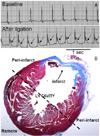1. Guth L. Regeneration in the mammalian peripheral nervous system. Physiol Rev. 1956. 36:441–478.
2. Levi-Montalcini R. Growth control of nerve cells by a protein factor and its antiserum. Science. 1964. 143:105–110.
3. Hirsch EF, Jellinik M, Cooper T, Kaiser GC, Barner HC, Borghard-Erdle AM. The Innervation of the Vertebrate Heart. 1970. Springfield:
4. Barber MJ, Mueller TM, Davies BG, Gill RM, Zipes DP. Interruption of sympathetic and vagal-mediated afferent responses by transmural myocardial infarction. Circulation. 1985. 72:623–631.
5. Nori SL, Gaudino M, Alessandrini F, Bronzetti E, Santarelli P. Immunohistochemical evidence for sympathetic denervation and reinnervation after necrotic injury in rat myocardium. Cell Mol Biol. 1995. 41:799–807.
6. Vracko R, Thorning D, Frederickson RG. Fate of nerve fibers in necrotic, healing, and healed rat myocardium. Lab Invest. 1990. 63:490–501.
7. Vracko R, Thorning D, Frederickson RG. Nerve fibers in human myocardial scars. Hum Pathol. 1991. 22:138–146.
8. Cao JM, Fishbein MC, Han JB, et al. Relationship between regional cardiac hyperinnervation and ventricular arrhythmia. Circulation. 2000. 101:1960–1969.
9. Zhou S, Chen LS, Miyauchi Y, et al. Mechanisms of cardiac nerve sprouting after myocardial infarction in dogs. Circ Res. 2004. 95:76–83.
10. Torrent-Guasp F, Buckberg GD, Clemente C, Cox JL, Coghlan HC, Gharib M. The structure and function of the helical heart and its buttress wrapping: I. the normal macroscopic structure of the heart. Semin Thorac Cardiovasc Surg. 2001. 13:301–319.
11. Buckberg GD, Weisfeldt ML, Ballester M, et al. Left ventricular form and function: scientific priorities and strategic planning for development of new views of disease. Circulation. 2004. 110:e333–e336.
12. Cao JM, Chen LS, KenKnight BH, et al. Nerve sprouting and sudden cardiac death. Circ Res. 2000. 86:816–821.
13. Zhou S, Cao JM, Tebb ZD, et al. Modulation of QT interval by cardiac sympathetic nerve sprouting and the mechanisms of ventricular arrhythmia in a canine model of sudden cardiac death. J Cardiovasc Electrophysiol. 2001. 12:1068–1073.
14. Abe T, Morgan DA, Gutterman DD. Protective role of nerve growth factor against postischemic dysfunction of sympathetic coronary innervation. Circulation. 1997. 95:213–220.
15. Fuchs M, Hilfiker A, Kaminski K, et al. Role of interleukin-6 for LV remodeling and survival after experimental myocardial infarction. FASEB J. 2003. 17:2118–2120.
16. Nian M, Lee P, Khaper N, Liu P. Inflammatory cytokines and postmyocardial infarction remodeling. Circ Res. 2004. 94:1543–1553.
17. Gwechenberger M, Mendoza LH, Youker KA, et al. Cardiac myocytes produce interleukin-6 in culture and in viable border zone of reperfused infarctions. Circulation. 1999. 99:546–551.
18. Reiss K, Meggs LG, Li P, Olivetti G, Capasso JM, Anversa P. Upregulation of IGF1, IGF1-receptor, and late growth related genes in ventricular myocytes acutely after infarction in rats. J Cell Physiol. 1994. 158:160–168.
19. Conti E, Andreotti F, Sciahbasi A, et al. Markedly reduced insulin-like growth factor-1 in the acute phase of myocardial infarction. J Am Coll Cardiol. 2001. 38:26–32.
20. Lijnen PJ, Petrov VV, Fagard RH. Induction of cardiac fibrosis by transforming growth factor-beta (1). Mol Genet Metab. 2000. 71:418–435.
21. Drapeau J, El Helou V, Clement R, et al. Nestin-expressing neural stem cells identified in the scar following myocardial infarction. J Cell Physiol. 2005. 204:51–62.
22. Park JW, Youn HJ, Chung WS, et al. Changes of responses of autonomic nervous system in patients after myocardial infarction. Korean Circ J. 1994. 24:272–279.
23. Lee TI, Choi KW, Kim YJ, et al. Effect of stress on cardiovascular autonomic nervouse activity in recovering myocardial infarction patients and normal controls measured by power spectral analysis. Korean Circ J. 1994. 24:24–37.
24. Zou Y, Takano H, Mizukami M, et al. Leukemia inhibitory factor enhances survival of cardiomyocytes and induces regeneration of myocardium after myocardial infarction. Circulation. 2003. 108:748–753.
25. Buerke M, Murohara T, Skurk C, Nuss C, Tomaselli K, Lefer AM. Cardioprotective effect of insulin-like growth factor I in myocardial ischemia followed by reperfusion. Proc Natl Acad Sci U S A. 1995. 92:8031–8035.
26. Kotlyar AA, Vered Z, Goldberg I, et al. Insulin-like growth factor I and II preserve myocardial structure in postinfarct swine. Heart. 2001. 86:693–700.
27. Kim DT, Luthringer DJ, Lai AC, et al. Sympathetic nerve sprouting after orthotopic heart transplantation. J Heart Lung Transplant. 2004. 23:1349–1358.
28. Bengel FM, Ueberfuhr P, Schiepel N, Nekolla SG, Reichart B, Schwaiger M. Myocardial efficiency and sympathetic reinnervation after orthotopic heart transplantation: a noninvasive study with positron emission tomography. Circulation. 2001. 103:1881–1886.
29. Luisi AJ, Fallavollita JA, Suzuki G, Canty JM. Spatial inhomogeneity of sympathetic nerve function in hibernating myocardium. Circulation. 2002. 106:779–781.
30. Canty JM, Suzuki G, Banas MD, Verheyen F, Borgers M, Fallavollita JA. Hibernating myocardium: chronically adapted to ischemia but vulnerable to sudden death. Circ Res. 2004. 94:1142–1149.
31. Cho IH, Lee JY, Shin DG, et al. Influence of autonomic nervous system in occlusion and reperfusion arrhythmia. Korean Circ J. 1990. 20:369–380.
32. Zolotareva AG, Kogan ME. Production of experimental occlusive myocardial infarction in mice. Cor Vasa. 1978. 20:308–314.











 PDF
PDF ePub
ePub Citation
Citation Print
Print


 XML Download
XML Download